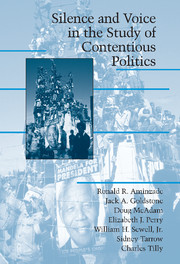Book contents
- Frontmatter
- Contents
- Preface
- 1 SILENCE AND VOICE IN THE STUDY OF CONTENTIOUS POLITICS: INTRODUCTION
- 2 EMOTIONS AND CONTENTIOUS POLITICS
- 3 SPACE IN CONTENTIOUS POLITICS
- 4 IT'S ABOUT TIME: TEMPORALITY IN THE STUDY OF SOCIAL MOVEMENTS AND REVOLUTIONS
- 5 LEADERSHIP DYNAMICS AND DYNAMICS OF CONTENTION
- 6 THE SACRED, RELIGIOUS, AND SECULAR IN CONTENTIOUS POLITICS: BLURRING BOUNDARIES
- 7 THREAT (AND OPPORTUNITY): POPULAR ACTION AND STATE RESPONSE IN THE DYNAMICS OF CONTENTIOUS ACTION
- 8 CONTENTION IN DEMOGRAPHIC AND LIFE-COURSE CONTEXT
- 9 HARMONIZING THE VOICES: THEMATIC CONTINUITY ACROSS THE CHAPTERS
- References
- Index
5 - LEADERSHIP DYNAMICS AND DYNAMICS OF CONTENTION
Published online by Cambridge University Press: 05 June 2012
- Frontmatter
- Contents
- Preface
- 1 SILENCE AND VOICE IN THE STUDY OF CONTENTIOUS POLITICS: INTRODUCTION
- 2 EMOTIONS AND CONTENTIOUS POLITICS
- 3 SPACE IN CONTENTIOUS POLITICS
- 4 IT'S ABOUT TIME: TEMPORALITY IN THE STUDY OF SOCIAL MOVEMENTS AND REVOLUTIONS
- 5 LEADERSHIP DYNAMICS AND DYNAMICS OF CONTENTION
- 6 THE SACRED, RELIGIOUS, AND SECULAR IN CONTENTIOUS POLITICS: BLURRING BOUNDARIES
- 7 THREAT (AND OPPORTUNITY): POPULAR ACTION AND STATE RESPONSE IN THE DYNAMICS OF CONTENTIOUS ACTION
- 8 CONTENTION IN DEMOGRAPHIC AND LIFE-COURSE CONTEXT
- 9 HARMONIZING THE VOICES: THEMATIC CONTINUITY ACROSS THE CHAPTERS
- References
- Index
Summary
Leadership is one of the most extensively researched topics in psychology and organization studies (Rosenbach and Taylor 1993; Sashkin and Lassey 1983). A focus on leadership as the wellspring of political action is found in Carlyle (1849), Freud (1965), Lasswell (1948), and Weber (1954), among many others. Despite this vast outpouring of scholarship, most research has focused on explaining leadership itself, rather than on its effects. That is, the bulk of scholarship is devoted to describing what kind of person (in terms of background or personal characteristics) becomes a leader (Mazlish 1976; Rejai and Phillips 1979), the various types of leadership (Sashkin and Rosenbach 1993; Weber 1954), the situations in which leadership emerges (Burns 1978), the relations between leaders and followers (Fiedler 1967), and the detailed lives or psychohistories of individual leaders (Erikson 1962; 1969; Wolfenstein 1967). Surprisingly little scholarship, particularly in regard to social movements and revolutions, has sought to determine the effect that variation in leadership dynamics – that is, in the relationships among revolutionary leaders, or between leaders and followers – have on the course and outcomes of contentious politics.
There are three main perspectives on the effect of leadership dynamics on movement dynamics in the classic sociological literature: the circulation of elites (Pareto), the tendency to oligarchy of elites (Michels), and the need to rationalize or institutionalize charismatic leadership (Weber). All are surprisingly negative in assessing the potential for revolutionary leadership to make a significant difference.
- Type
- Chapter
- Information
- Silence and Voice in the Study of Contentious Politics , pp. 126 - 154Publisher: Cambridge University PressPrint publication year: 2001
- 43
- Cited by

